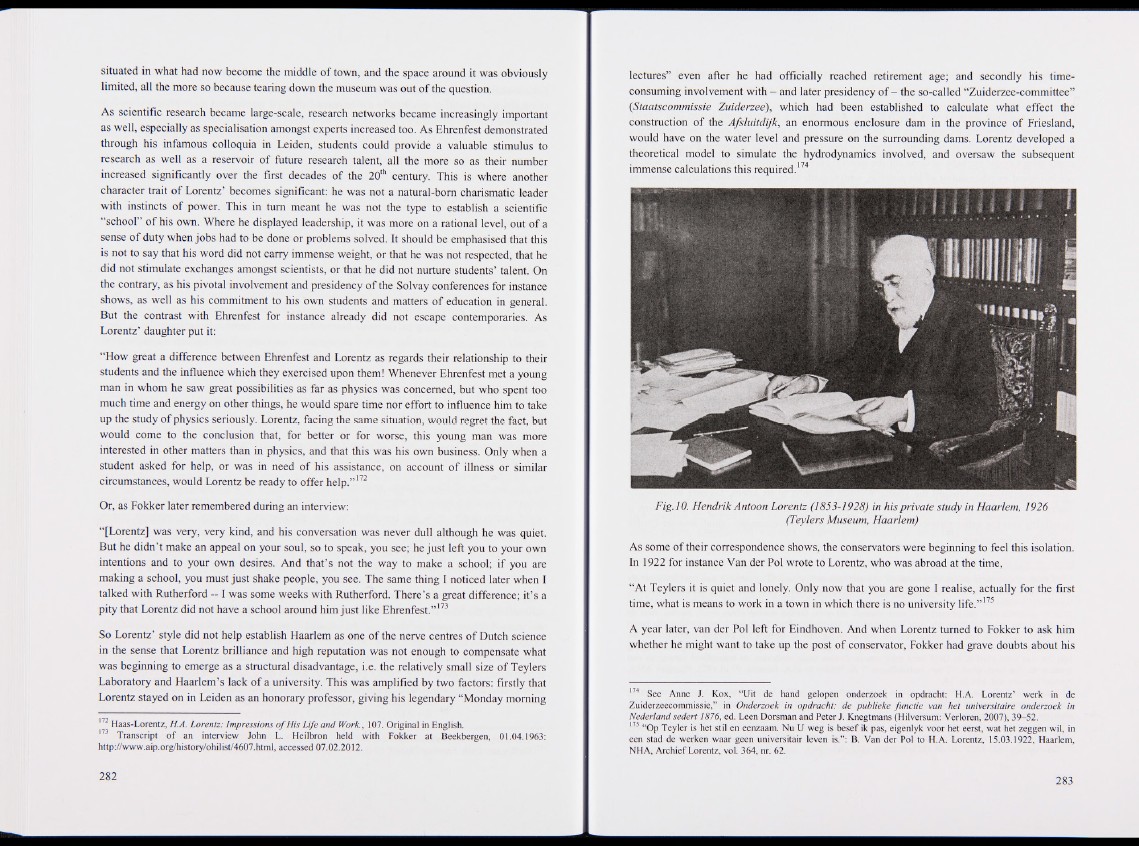
situated in what had now become the middle of town, and the space around it was obviously
limited, all the more so because tearing down the museum was out of the question.
As scientific research became large-scale, research networks became increasingly important
as well, especially as specialisation amongst experts increased too. As Ehrenfest demonstrated
through his infamous colloquia in Leiden, students could provide a valuable stimulus to
research as well as a reservoir of future research talent, all the more so as their number
increased significantly over the first decades of the 20th century. This is where another
character trait of Lorentz’ becomes significant: he was not a natural-born charismatic leader
with instincts of power. This in turn meant he was not the type to establish a scientific
“school” of his own. Where he displayed leadership, it was more on a rational level, out of a
sense of duty when jobs had to be done or problems solved. It should be emphasised that this
is not to say that his word did not carry immense weight, or that he was not respected, that he
did not stimulate exchanges amongst scientists, or that he did not nurture students’ talent. On
the contrary, as his pivotal involvement and presidency of the Solvay conferences for instance
shows, as well as his commitment to his own students and matters of education in general.
But the contrast with Ehrenfest for instance already did not escape contemporaries. As
Lorentz’ daughter put it:
“How great a difference between Ehrenfest and Lorentz as regards their relationship to their
students and the influence which they exercised upon them! Whenever Ehrenfest met a young
man in whom he saw great possibilities as far as physics was concerned, but who spent too
much time and energy on other things, he would spare time nor effort to influence him to take
up the study of physics seriously. Lorentz, facing the same situation, would regret the fact, but
would come to the conclusion that, for better or for worse, this young man was more
interested in other matters than in physics, and that this was his own business. Only when a
student asked for help, or was in need of his assistance, on account of illness or similar
circumstances, would Lorentz be ready to offer help.”172
Or, as Fokker later remembered during an interview:
“[Lorentz] was very, very kind, and his conversation was never dull although he was quiet.
But he didn’t make an appeal on your soul, so to speak, you see; he just left you to your own
intentions and to your own desires. And that’s not the way to make a school; if you are
making a school, you must just shake people, you see. The same thing I noticed later when I
talked with Rutherford — I was some weeks with Rutherford. There’s a great difference; it’s a
pity that Lorentz did not have a school around him just like Ehrenfest.”173
So Lorentz’ style did not help establish Haarlem as one of the nerve centres of Dutch science
in the sense that Lorentz brilliance and high reputation was not enough to compensate what
was beginning to emerge as a structural disadvantage, i.e. the relatively small size of Teylers
Laboratory and Haarlem’s lack of a university. This was amplified by two factors: firstly that
Lorentz stayed on in Leiden as an honorary professor, giving his legendary “Monday morning
Haas-Lorentz, H.A. Lorentz: Impressions o f His Life and Work., 107. Original in English.
17 Transcript o f an interview John L. Heilbron held with Fokker at Beekbergen, 01.04.1963:
http://www.aip.org/history/ohilist/4607.html, accessed 07.02.2012.
lectures” even after he had officially reached retirement age; and secondly his time-
consuming involvement with - and later presidency of - the so-called “Zuiderzee-committee”
(Staatscommissie Zuiderzee), which had been established to calculate what effect the
construction of the Afsluitdijk, an enormous enclosure dam in the province of Friesland,
would have on the water level and pressure on the surrounding dams. Lorentz developed a
theoretical model to simulate the hydrodynamics involved, and oversaw the subsequent
immense calculations this required. 7
Fig.10. Hendrik Antoon Lorentz (1853-1928) in his private study in Haarlem, 1926
(Teylers Museum, Haarlem)
As some of their correspondence shows, the conservators were beginning to feel this isolation.
In 1922 for instance Van der Pol wrote to Lorentz, who was abroad at the time,
“At Teylers it is quiet and lonely. Only now that you are gone I realise, actually for the first
time, what is means to work in a town in which there is no university life.” 175
A year later, van der Pol left for Eindhoven. And when Lorentz turned to Fokker to ask him
whether he might want to take up the post of conservator, Fokker had grave doubts about his
174 See Anne J. Kox, “Uit de hand gelopen onderzoek in opdracht: H.A. Lorentz’ werk in de
Zuiderzeecommissie,” in Onderzoek in opdracht: de publieke functie van het universitaire onderzoek in
Nederland sedert 1876, ed. Leen Dorsman and Peter J. Knegtmans (Hilversum: Verloren, 2007), 39-52.
175 “Op Teyler is het stil en eenzaam. Nu U weg is besef ik pas, eigenlyk voor het eerst, wat het zeggen wil, in
een stad de werken waar geen universitair leven is.”: B. Van der Pol to H.A. Lorentz, 15.03.1922, Haarlem,
NHA, Archief Lorentz, vol. 364, nr. 62.